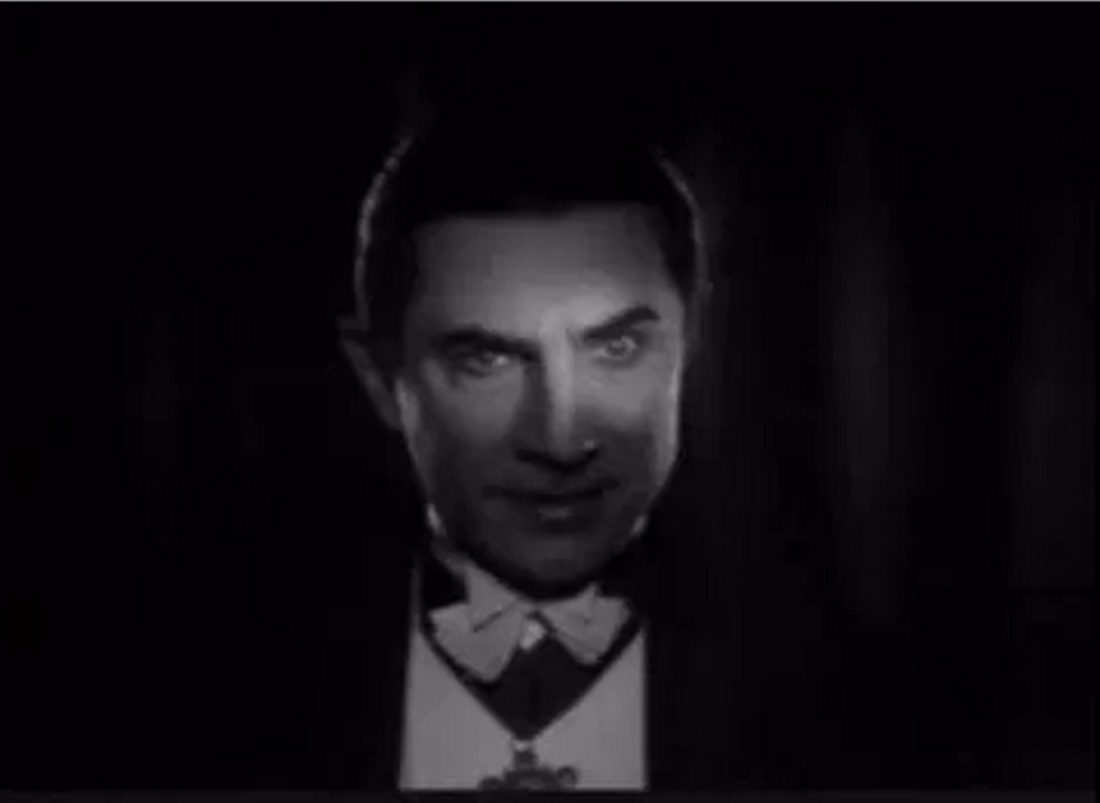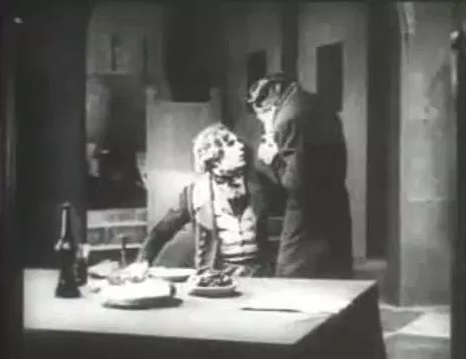Two of the most important passages pertaining to homosexuality in Dracula (and subsequently, the movie scenes they correspond to), are these passages from chapters two and three:
from the beginning of chapter two, when Harker is preparing for the day:
I had hung my shaving glass by the window, and was just beginning to shave. Suddenly I felt a hand on my shoulder, and heard the Count’s voice saying to me, “Good morning.” I started, for it amazed me that I had not seen him, since the reflection of the glass covered the whole room behind me. In starting I had cut myself slightly, but did not notice it at the moment. Having answered the Count’s salutation, I turned to the glass again to see how I had been mistaken. This time there could be no error, for the man was close to me, and I could see him over my shoulder. But there was no reflection of him in the mirror! The whole room behind me was displayed, but there was no sign of a man in it, except myself. This was startling, and coming on the top of so many strange things, was beginning to increase that vague feeling of uneasiness which I always have when the Count is near. But at the instant I saw the cut had bled a little, and the blood was trickling over my chin. I laid down the razor, turning as I did so half round to look for some sticking plaster. When the Count saw my face, his eyes blazed with a sort of demoniac fury, and he suddenly made a grab at my throat. I drew away and his hand touched the string of beads which held the crucifix. It made an instant change in him, for the fury passed so quickly that I could hardly believe that it was ever there. “Take care,” he said, “take care how you cut yourself. It is more dangerous that you think in this country.”
from later in chapter two:
I went out on the stairs, and found a room looking towards the South. The view was magnificent, and from where I stood there was every opportunity of seeing it. The castle is on the very edge of a terrific precipice. A stone falling from the window would fall a thousand feet without touching anything! As far as the eye can reach is a sea of green tree tops, with occasionally a deep rift where there is a chasm. Here and there are silver threads where the rivers wind in deep gorges through the forests. But I am not in heart to describe beauty, for when I had seen the view I explored further. Doors, doors, doors everywhere, and all locked and bolted. In no place save from the windows in the castle walls is there an available exit. The castle is a veritable prison, and I am a prisoner!
from chapter three, when Dracula’s wives are advancing on Harker:
With a fierce sweep of his arm, he hurled the woman from him, and then motioned to the others, as though he were beating them back. It was the same imperious gesture that I had seen used to the wolves. In a voice which, though low and almost in a whisper seemed to cut through the air and then ring in the room he said, “How dare you touch him, any of you? How dare you cast eyes on him when I had forbidden it? Back, I tell you all! This man belongs to me! Beware how you meddle with him, or you’ll have to deal with me.”
The fair girl, with a laugh of ribald coquetry, turned to answer him. “You yourself never loved. You never love!” On this the other women joined, and such a mirthless, hard, soulless laughter rang through the room that it almost made me faint to hear. It seemed like the pleasure of fiends.
Then the Count turned, after looking at my face attentively, and said in a soft whisper, “Yes, I too can love. You yourselves can tell it from the past. Is it not so? Well, now I promise you that when I am done with him you shall kiss him at your will. Now go! Go! I must awaken him, for there is work to be done.” …Then the horror overcame me, and I sank down unconscious.
(Dracula, ch. 2-3 literature.org)
These chapters is very important to explaining the themes of homosexuality mentioned above because it not only sets up the tone for the character of Dracula as a seductive and frightening character, but it also highlights many of the things that Stoker wrestled against. In this chapter, naïve Jonathan Harker represents Stoker. Harker is often unsure of his host Dracula’s intentions. His narration-which includes his uncomfortable actions when Dracula is near-describes the curiosity, magnetism, and fear he feels around Dracula. Conversely, this describes Stoker attempting to reconcile his homosexuality—he is tempted by the idea of being liberated, but he is afraid of the consequences and doesn’t want to endure what Wilde went though in court. For Stoker, Dracula’s resemblance to Whitman doesn’t stop at his appearance; Dracula, like Whitman, represents freedom from societal constraints about sexuality and gender and the courage to live true to oneself. Evidence of this is Dracula’s exclamation that he does love, alluding to the idea that he is love with Harker. In Stoker’s novel, only Dracula would be able to unabashedly admit that he is love with another man, similarly to how Whitman might be able to proclaim such an admission without regrets. Harker is both afraid of and lured in by his host, just like Stoker might have been afraid of living true to himself like his idol Whitman. Like how Harker felt trapped in Dracula’s castle, Stoker felt trapped in society as well as his mind and body. Most importantly, Dracula’s proclamation of Harker being his, coupled with Harker fainting, further represents the power and fear of facing the truth as well as the unwillingness to accept his homosexuality.
This theme of the temptation and fear of the unknown stays prevalent throughout most-if not all-film interpretations ofDracula. In the film Nosferatu, the names of the characters may have changed and the location may be different (the film is set primarily Germany while the novel is set primarily in London), but the sexual allusions are still present, albeit tampered down when it comes to scenes involving Harker-who is named Hutter in this film-and Count Orlock.
In Nosferatu. Hutter knows that Orlock represents something otherworldy, but at the moment, he doesn’t initially know this. In one of the scenes where Hutter is in Orlock’s castle, Orlock is reading a paper while Hutter is apprehensively eating dinner. As he starts cutting some bread, Hutter looks at Orlock with a mixture of fear and curiosity, much like how Harker’s narrative tone in Dracula. He becomes lost in his thoughts about Orlock, and a ringing clock startles him, leading to him cutting himself with the knife. Orlock becomes enraptured at the sight of blood, grabs Hutter’s thumb, and sucks it until Hutter, horrified, jerks away.
Figures 2- 8 (youtube.com)
This interpretation of the book differs in many ways. Firstly, Hutter is cut in a different place rather than where Harker was cut-Harker was cut near his mouth, which immediately has more suggestive connotations. Dracula also makes a grab at Harker’s throat, unlike Orlock-because such suggestive advances are changed in the above scene, the book’s themes of homosexuality are taken away and only the idea of virtue vanquishing evil remain in the form of Hutter’s wife Ellen sacrificing herself in order to kill Orlock. However, the idea that blood represents intimacy still exists; the way Orlock loses self-control to drink Hutter’s blood is allegorical to the idea of stealing a kiss. Also, the consuming fear Hutter develops after Orlock sucks his cut is simple to understand on the surface, but it can also represent the fear of the deviant or the misunderstood in society. When Nosferatu, a German film, was made, Hitler had taken control of the Nazi Party and was already preaching against Jews and other minorities, including homosexuals. While Nosferatu has been thought of as an anti-Semitic film, it can also be seen as an anti-homosexual film because of the rhetoric against the gay lifestyle.
In the 1931 film Dracula, the same theme of the unknown is blown up to bigger and more obvious proportions, however, in this film, the man in Dracula’s castle is estate agent Renfield, not Harker, who appears later in the film as a person in the higher echelons of society. In this film, the allure of Dracula starts much earlier than in Nosferatu. The very moment the estate agent lays eyes on Dracula, he is more in awe of him and is more curious, whereas in Nosferatu, Hutter is mostly repulsed by his host. The 1931 version of Count Dracula is much closer to the book character, who is very mysterious, elegant, glamorous, dangerous, and attractive, but his attributes are almost in caricature. Even Dracula’s manner of dress—a long black cape with a crisp tuxedo and ornamentation—is meant to draw people closer to him, as a Venus Flytrap draws flies to it by its bright pink color.
The scene in which Renfield pricks himself is a lot more subversive than the scene from Nosferatu. Instead of immediate repulsion like evidenced in Nosferatu, there is a play on the seductive and homosexual implications evident in the book in the film version of Dracula. Some constants are still the same-Renfield pricks his finger and Dracula becomes immediately taken by the sight of blood, but the differences between the scenes start when Renfield’s crucifix falls into the shot, repelling Dracula. Renfield, having not seen Dracula’s reactions to blood and the crucifix, thinks Dracula is simply concerned, and reassures him that it’s only a cut from a paper clip. Dracula merely looks on as Renfield then proceeds to suck his finger and smiles at him.







